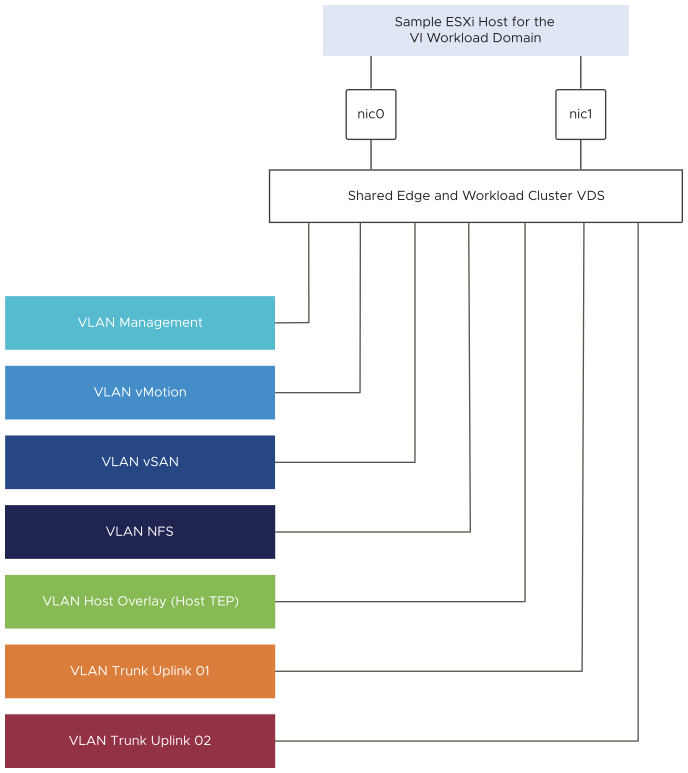The design of a distributed port group specifies port configuration options for each member port on a vSphere Distributed Switch. Distributed port groups define how a connection is made to a network.
Port Group Configuration
The port group configuration of the distributed switch for a VI workload domain follows the network configuration for the domain in VMware Cloud Foundation.

| Networks | Port Group Function |
Port Binding |
Teaming Policy |
Active Uplinks |
Failover Detection |
Notify Switches |
Failback |
|---|---|---|---|---|---|---|---|
| Management VLAN | Management |
Static Port Binding |
Route based on physical NIC load |
1, 2 |
Link status only |
Yes |
Yes |
| vSphere vMotion VLAN | vMotion |
Static Port Binding |
Route based on physical NIC load |
1, 2 |
Link status only |
Yes |
Yes |
| vSAN VLAN | vSAN |
Static Port Binding |
Route based on physical NIC load |
1, 2 |
Link status only |
Yes |
Yes |
| NFS VLAN | NFS (Optional/ Manually created) |
Static Port Binding |
Route based on physical NIC load |
1, 2 |
Link status only |
Yes |
Yes |
| Host overlay (TEP) VLAN | The host overlay (TEP) traffic is not assigned a distributed port group. It is directly mapped to the switch uplinks. See Overlay Design for a Virtual Infrastructure Workload Domain. |
||||||
|
Edge Uplink01 |
See Network Design for the NSX Edge Nodes for a Virtual Infrastructure Workload Domain. |
|||||
| Edge Uplink02 |
|||||||
NIC Teaming
For a predictable level of performance and for high availability, use multiple network adapters in one of the following configurations.
An active-passive configuration that uses explicit failover when connected to two separate switches.
An active-active configuration in which two or more physical NICs in the server are assigned the active role.
Decision ID |
Design Decision |
Design Justification |
Design Implication |
|---|---|---|---|
VCF-WLD-VCS-VDS-003 |
Use static port binding for all port groups in a VI workload domain cluster. |
|
None |
VCF-WLD-VCS-VDS-004 |
Use the |
Reduces the complexity of the network design and increases resiliency and performance. |
None |
VCF-WLD-VCS-VDS-005 |
Use the |
Reduces the complexity of the network design and increases resiliency and performance. |
None |
VMkernel Network Adapter Configuration
The VMkernel networking layer provides connectivity to hosts and handles the system traffic for management, vSphere vMotion, vSphere HA, vSAN, and others.
VMkernel Adapter Service |
Connected Port Group |
Enabled Services |
MTU Size (Bytes) |
|---|---|---|---|
Management |
Management Port Group |
Management Traffic |
1500 (Default) |
vMotion |
vMotion Port Group |
vMotion Traffic |
9000 |
vSAN |
vSAN Port Group |
vSAN |
9000 |
Availability Zones |
VMkernel Adapter Service |
Connected Port Group |
Enabled Services |
MTU Size (Bytes) |
|---|---|---|---|---|
First availability zone |
Management |
Management port group for the first availability zone |
Management Traffic |
1500 (Default) |
vMotion |
vSphere vMotion port group for the first availability zone |
vMotion Traffic |
9000 |
|
vSAN |
vSAN port group for the first availability zone |
vSAN |
9000 |
|
Second availability zone |
Management |
Management port group for the second availbaility zone |
Management Traffic |
1500 (Default) |
vMotion |
vSphere vMotion port group for the second availability zone |
vMotion Traffic |
9000 |
|
vSAN |
vSAN port group for the second availability zone |
vSAN |
9000 |